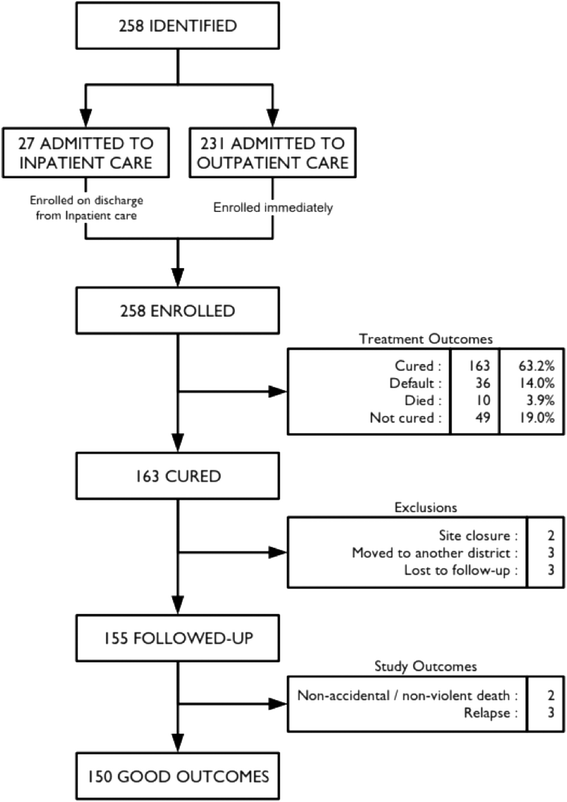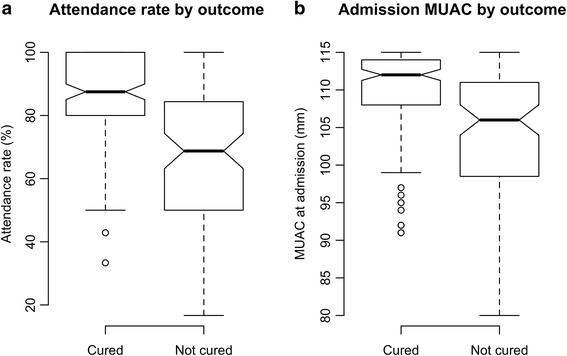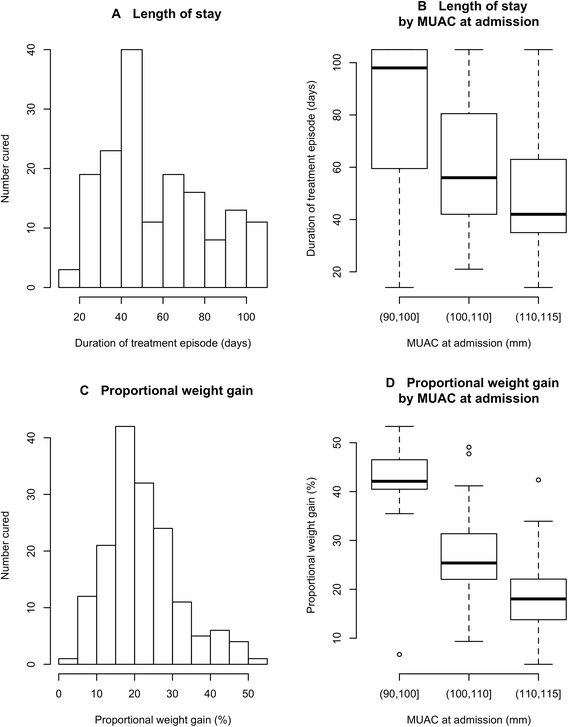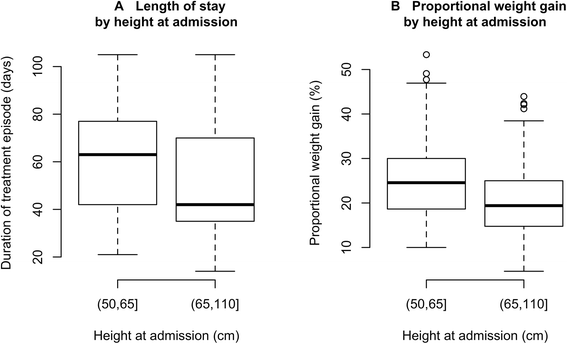Safety and practicability of using mid-upper arm circumference as a discharge criterion in community based management of severe acute malnutrition in children aged 6 to 59 months programmes
- PMID: 27307989
- PMCID: PMC4908708
- DOI: 10.1186/s13690-016-0136-x
Safety and practicability of using mid-upper arm circumference as a discharge criterion in community based management of severe acute malnutrition in children aged 6 to 59 months programmes
Abstract
Background: The use of proportional weight gain as a discharge criterion for MUAC admissions to programs treating severe acute malnutrition (SAM) is no longer recommended by WHO. The critical limitation with the proportional weight gain criterion was that children who are most severely malnourished tended to receive shorter treatment compared to less severely malnourished children. Studies have shown that using a discharge criterion of MUAC ≥ 125 mm eliminates this problem but concerns remain over the duration of treatment required to reach this criterion and whether this discharge criterion is safe. This study assessed the safety and practicability of using MUAC ≥ 125 mm as a discharge criterion for community based management of SAM in children aged 6 to 59 months.
Methods: A standards-based trial was undertaken in health facilities for the outpatient treatment of SAM in Lilongwe District, Malawi. 258 children aged 6 to 51 months were enrolled with uncomplicated SAM as defined by a MUAC equal or less than 115 mm without serious medical complications. Children were discharged from treatment as 'cured' when they achieved a MUAC of 125 mm or greater for two consecutive visits. After discharge, children were followed-up at home every two weeks for three months.
Results: This study confirms that a MUAC discharge criterion of 125 mm or greater is a safe discharge criterion and is associated with low levels of relapse to SAM (1.9 %) and mortality (1.3 %) with long durations of treatment seen only in the most severe SAM cases. The proportion of children experiencing a negative outcome was 3.2 % and significantly below the 10 % standard (p = 0.0013) established for the study. All children with negative outcomes had achieved weight-for-height z-score (WHZ) above -1 z-scores at discharge. Children admitted with lower MUAC had higher proportional weight gains (p < 0.001) and longer lengths of stay (p < 0.0001). MUAC at admission and attendance were both independently associated with cure (p < 0.0001). There was no association with negative outcomes at three months post discharge for children with heights at admission below 65 cm than for taller children (p = 0.5798).
Conclusions: These results are consistent with MUAC ≥ 125 mm for two consecutive visits being a safe and practicable discharge criterion. Use of a MUAC threshold of 125 mm for discharge achieves reasonable lengths of stay and was also found to be appropriate for children aged six months or older who are less than 65 cm in height at admission. Early detection and recruitment of SAM cases using MUAC in the community and compliance with the CMAM treatment protocols should reduce lengths of stay and associated treatment costs.
Keywords: Discharge criteria; Mid Upper Arm Circumference (MUAC); Severe Acute Malnutrition (SAM).
Figures





Similar articles
-
A feasibility study using mid-upper arm circumference as the sole anthropometric criterion for admission and discharge in the outpatient treatment for severe acute malnutrition.BMC Nutr. 2021 Aug 12;7(1):47. doi: 10.1186/s40795-021-00448-w. BMC Nutr. 2021. PMID: 34380573 Free PMC article.
-
Does treatment of short or stunted children aged 6-59 months for severe acute malnutrition using ready to use therapeutic food make them overweight? Data from Malawi.Arch Public Health. 2018 Dec 13;76:78. doi: 10.1186/s13690-018-0321-1. eCollection 2018. Arch Public Health. 2018. PMID: 30559964 Free PMC article.
-
Anthropometry at discharge and risk of relapse in children treated for severe acute malnutrition: a prospective cohort study in rural Nepal.Nutr J. 2021 Apr 5;20(1):32. doi: 10.1186/s12937-021-00684-7. Nutr J. 2021. PMID: 33820545 Free PMC article.
-
Severely malnourished children with a low weight-for-height have similar mortality to those with a low mid-upper-arm-circumference: II. Systematic literature review and meta-analysis.Nutr J. 2018 Sep 15;17(1):80. doi: 10.1186/s12937-018-0383-5. Nutr J. 2018. PMID: 30217196 Free PMC article.
-
Use of Mid-Upper Arm Circumference by Novel Community Platforms to Detect, Diagnose, and Treat Severe Acute Malnutrition in Children: A Systematic Review.Glob Health Sci Pract. 2018 Oct 4;6(3):552-564. doi: 10.9745/GHSP-D-18-00105. Print 2018 Oct 3. Glob Health Sci Pract. 2018. PMID: 30185435 Free PMC article.
Cited by
-
A feasibility study using mid-upper arm circumference as the sole anthropometric criterion for admission and discharge in the outpatient treatment for severe acute malnutrition.BMC Nutr. 2021 Aug 12;7(1):47. doi: 10.1186/s40795-021-00448-w. BMC Nutr. 2021. PMID: 34380573 Free PMC article.
-
Time to full recovery and its predictors among children with complicated severe acute malnutrition admitted to inpatient and subsequently to outpatient therapeutic care, Sana'a city, Yemen, a prospective follow-up study.BMJ Open. 2025 Jul 16;15(7):e101454. doi: 10.1136/bmjopen-2025-101454. BMJ Open. 2025. PMID: 40669907 Free PMC article.
-
How do children with severe underweight and wasting respond to treatment? A pooled secondary data analysis to inform future intervention studies.Matern Child Nutr. 2023 Jan;19(1):e13434. doi: 10.1111/mcn.13434. Epub 2022 Oct 19. Matern Child Nutr. 2023. PMID: 36262055 Free PMC article.
-
Mothers screening for malnutrition by mid-upper arm circumference is non-inferior to community health workers: results from a large-scale pragmatic trial in rural Niger.Arch Public Health. 2016 Sep 6;74(1):38. doi: 10.1186/s13690-016-0149-5. eCollection 2016. Arch Public Health. 2016. PMID: 27602207 Free PMC article.
-
Relapse and post-discharge body composition of children treated for acute malnutrition using a simplified, combined protocol: A nested cohort from the ComPAS RCT.PLoS One. 2021 Feb 3;16(2):e0245477. doi: 10.1371/journal.pone.0245477. eCollection 2021. PLoS One. 2021. PMID: 33534818 Free PMC article. Clinical Trial.
References
-
- WHO, WFP, UNSCN, UNICEF . Community-Based Management of Severe Acute Malnutrition: A Joint Statement by the World Health Organization, the World Food Programme, the United Nations System Standing Committee on Nutrition and the United Nations Children’s Fund. Geneva: World Health Organization, World Food Programme, United Nations System Standing Committee on Nutrition, United Nations Children’s Fund; 2007.
-
- WHO . Guideline: Updates on the management of severe acute malnutrition in infants and children. Geneva: World Health Organisation; 2013. - PubMed
-
- ENN . Mid-Upper Arm Circumference and Weight-for-Height Z score as indicators of severe acute malnutrition: A consultation of operational agencies and academic specialists to understand the evidence, identify knowledge gaps and to inform operational guidance. 2012.
LinkOut - more resources
Full Text Sources
Other Literature Sources

